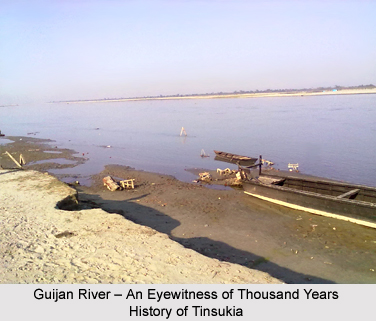 History of Tinsukia District consists of vast historical accounts of the empire of the North East. The ancient name of the Tinsukia district was Bangmara. As per the history of Tinsukia District, this region was originally known as Changmai Pathar. Tinsukia was the capital of Muttack Kingdom. King Sarbananda Singha built Bangmara city with the help of his minister Gopinath Barbaruah. Bangmara city was built in the middle of the Tinsukia city. Historical evidences of Tinsukia District suggest that as per the direction of King Sarbananda Singha, Godha Baruah dug a triangular shaped pond in Bangmara city, which is known as "Tinikunia Pukhari". In the year 1884, Dibru-Sadiya rail line was constructed and a station was setup near the "Tinikunia Pukhari" which was named as Tinsukia. Since then the city is popularly known as Tinsukia.
History of Tinsukia District consists of vast historical accounts of the empire of the North East. The ancient name of the Tinsukia district was Bangmara. As per the history of Tinsukia District, this region was originally known as Changmai Pathar. Tinsukia was the capital of Muttack Kingdom. King Sarbananda Singha built Bangmara city with the help of his minister Gopinath Barbaruah. Bangmara city was built in the middle of the Tinsukia city. Historical evidences of Tinsukia District suggest that as per the direction of King Sarbananda Singha, Godha Baruah dug a triangular shaped pond in Bangmara city, which is known as "Tinikunia Pukhari". In the year 1884, Dibru-Sadiya rail line was constructed and a station was setup near the "Tinikunia Pukhari" which was named as Tinsukia. Since then the city is popularly known as Tinsukia.
The Muttack Kingdom occupied a distinct place in the history of Tinsukia District. The Muttacks transformed the history of the Ahom Kingdom by leading the historic Moamareeya Rebellion. This event was described as the first socio-political movement in the history of Tinsukia District. According to the map prepared by Captain Hamilton Vetch in 1841, a large portion of present Dibrugarh District and Tinsukia District had been identified as "Bengmara Country of Moamareeya Tribe" with its capital at Bengmara (present Tinsukia). Further, in the history of Tinsukia District, Bengmara city was later popularly known as Muttack city of Soumar.
The First King of Muttack Kingdom was Swargadeo Sarbananda Singha. Sarbananada Singha established his capital at Rangagarah situated in the bank of Guijan River. Swargadeo Sarbananda Singha was considered as an able administrator. History of Tinsukia District specifically mentions his determination, spirit and love for freedom. In 1791 AD, he transferred his capital to Bengmara. Several tanks were dug in the days of Sarbananda Singha namely Chauldhuwa Pukhari, Kadamoni Pukhari, Da Dharua Pukhari, Mahdhuwa Pukhari, Bator Pukhari, Logoni Pukhari, Na-Pukhari, Devi Pukhari, Kumbhi Pukhari, Rupahi Pukhari, etc. Apart from these ponds there are many ancient roads constructed in different parts of the Muttack territory. Godha-Borbaruah road, Rangagarah road, Rajgor road and Hatiali road were main roads within the territory.
In the year 1823, British East India Company first discovered Tea Plant in Sadiya and the first Tea Plantation was started in Chabua near Tinsukia. The name Chabua comes from "Chah-Buwa" (Tea Plantation). Other important events that took place under the British regime are following:
* In the year 1876 Coal was found near Ledo and Margherita
* In the year 1882 Crude Oil was struck in Digboi and country`s first oil well was built at Digboi Oil Town in 1889 and the refinery which was later built at Digboi was the first refinery in Asia and third in the world.
* History of Tinsukia District also recollects that the establishment of Railway and Trading Company in the region was a major turning point in its economic development.
* Adarsha Prathamic Vidyalaya, first educational institute of Tinsukia, was established in the year 1897. Later after the independence in the year 1947, Tinsukia District was declared as the 23rd administrative district of Assam on 1st October 1989 with three sub divisions - Margherita (Sadar), Tinsukia, and Sadiya.






